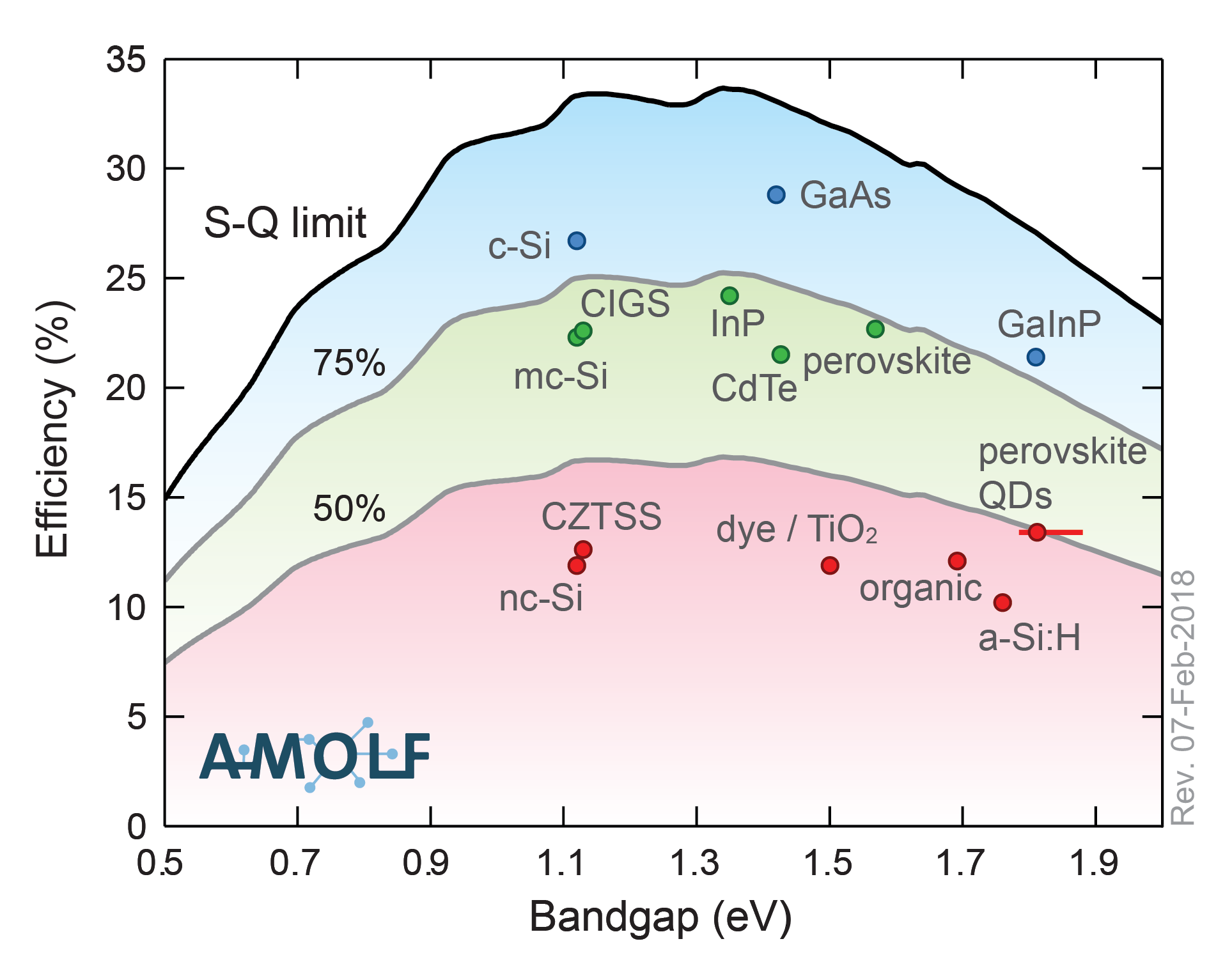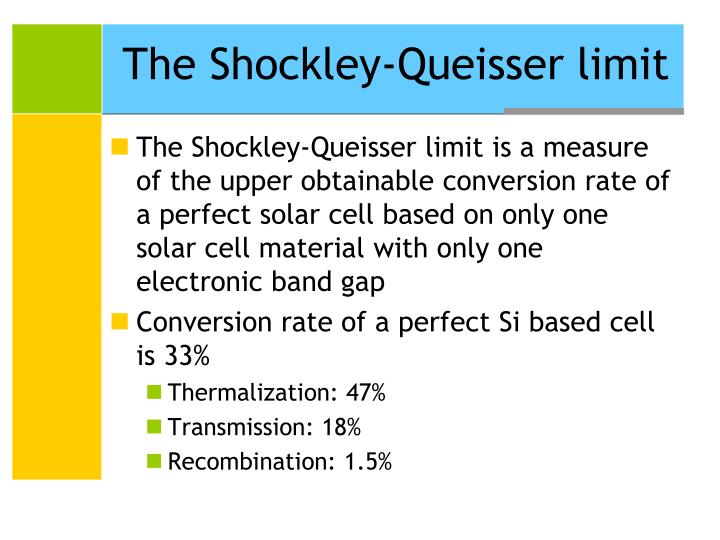
Resources ECE 695S Student Lecture 17 Plasmonic Photovoltaics Watch Presentation
The Shockley-Queisser limit. The Schockley-Queisser (SQ) limit is a famous limit on the maximal possible efficiency of solar cells, limited only by fundamental physics. It applies to most solar cell designs in the world, except for "tandem solar cells" and some additional obscure exceptions (discussed at the end of the document).
4 ShockleyQueisser limit at various temperatures from 5 • C to 85 •... Download Scientific
In March 1961, an article entitled Detailed Balance Limit of Efficiency of p-n Junction Solar Cells by William Shockley and Hans Joachim Queisser appeared in the Journal of Applied Physics (Shockley & Queisser, 1961 ).

Calculated ShockleyQueisser limits for triple junction solar cells for... Download Scientific
Metrics To the Editor — In a recent paper, Guillemoles et al. 1 attempt to clarify and explain the often cited paper by Shockley and Queisser 2 (SQ), which defines the limits to photovoltaic.

Detailed Balance limit (ShockleyQueisser limit) for a shortcircuit... Download Scientific
The Shockley-Queisser limit is one of the most fundamental results in the field of photovoltaics. Based on the principle of detailed balance, it defines an upper limit for a single junction solar cell that uses an absorber material with a specific band gap.

ShockleyQueisser triangle predicts the thermodynamic efficiency limits of arbitrarily complex
In physics, the radiative efficiency limit (also known as the detailed balance limit, Shockley-Queisser limit, Shockley Queisser Efficiency Limit or SQ Limit) is the maximum theoretical efficiency of a solar cell using a single p-n junction to collect power from the cell where the only loss mechanism is radiative recombination in the solar cell.

Resources Thermionic Escape in Quantum Well Solar Cell Watch Presentation
Received: 13 June 2021 Revised: 13 June 2021 DOI: 10.1002/wene.430 Accepted: 20 November 2021 A D V A N C E D R E V I E W Shockley: Queisser detailed balance limit after 60 years Tom Markvart1,2 1Engineering Sciences, University of Southampton, Southampton, UK 2Centre for Advanced Photovoltaics, Czech Technical University, Prague 6, Czech Republic

3 Schematic illustration of the ShockleyQueisser limit. The... Download Scientific Diagram
The Shockley-Quiesser Limit. There is a maximal theoretical conversion efficiency limit for single junction solar cells, such as wafer based crystalline silicon solar cells. This efficiency limit is known as the Shockley-Queisser limit, and takes into acount the optical and electrical loss mechanisms that are fundamentally required. In this.

ShockleyQueisser limit Wikiwand
The Shockley-Queisser model is a landmark in photovoltaic device analysis by defining an ideal situation as reference for actual solar cells. However, the model and its implications are easily.
Curva del límite de eficiencia de ShockleyQueisser. Fuente [3] Download Scientific Diagram
Although many PV technologies have been demonstrated so far, all the single-junction PVs are still subjected to the well-known efficiency cap of the Shockley-Queisser limit (33.7%), with most of the absorbed solar energy lost into heat.

ShockleyQueisser limit (Rühle, 2016). Download Scientific Diagram
The Schockley-Queisser (SQ) limit is a famous limit on the maximal possible efficiency of solar cells, limited only by fundamen- tal physics. It applies to most solar cell designs in the world, except for "tandem solar cells" and some additional obscure excep-

SQ Charts LMPV
Since 2016, we have maintained a website (1) that tracks the record efficiency and other performance parameters compared to the thermodynamic Shockley-Queisser (SQ) limit for solar cells made from 14 extensively studied semiconductor materials.

Shockley Queisser limit for solar cells Part 2 YouTube
This limits the maximum output of the cell. The maximum conversion efficiency is 33.7%. The theoretical limit is the maximum amount of energy extracted per incident photon. The Shockley-Queisser limit is around 6000 K blackbody radiation.

PPT Solar Energy Part 2 Photovoltaic cells PowerPoint Presentation ID3977055
The Shockley-Queisser limit describes the maximum solar energy conversion efficiency achievable for a particular material and is the standard by which new photovoltaic technologies are compared.

Perovskite Compositional Change with Time (A) ShockleyQueisser limit... Download Scientific
The limiting power conversion efficiency (PCE) defines the theoretical maximum efficiency of photovoltaic devices. The classic Shockley-Queisser method has predicted 33% for a single p-n junction solar cell under AM1.5G illumination, but those for alternative photovoltaic materials and under other illuminati Journal of Materials Chemistry A HOT Papers

ShockleyQueisser limit at different temperatures. The thicker segments... Download Scientific
The Shockley-Queisser limit is calculated by examining the amount of electrical energy that is extracted per incident photon. The calculation places maximum solar conversion efficiency around 33.7% assuming a single pn junction with a band gap of 1.4 eV (using an AM 1.5 solar spectrum).

ShockleyQueisser limit for simultaneous energy harvesting. a Schematic... Download Scientific
The Shockley-Queisser limit for solar cells is overcome in the ferroelectric insulator BaTiO3. Ferroelectric absorbers, which promote carrier separation and exhibit above-gap photovoltages, are.